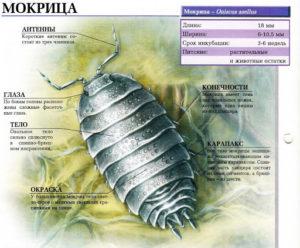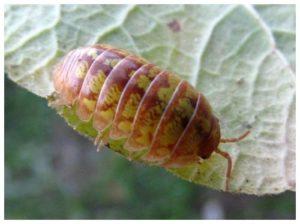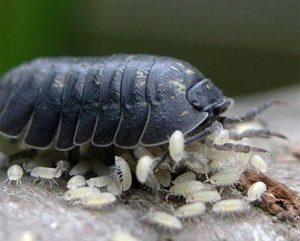Woodlice: photos of crustaceans and features of their vital activity
Both in cities and in rural areas, people constantly encounter various insects. They can be completely harmless creatures, or quite dangerous pests. It is to the number of harmful "neighbors" that it is customary to include wood lice.
Content
Woodlice: photo
Description of the pest
Name: Woodlice
Latin: oniscideaClass: Higher crayfish - Malacostraca
Squad: Equopods - Isopoda
 | Habitats: | with high humidity |
 | Catering: | scavengers |
 | Means of destruction: | various chemicals |
In fact, the opinion that wood lice are insects is erroneous. These small creatures belong to the suborder of crustaceans and are considered one of its most developed representatives.
What do wood lice look like
Most woodlice are small in size and their body length is from 1 to 2,5 cm. The color of these creatures is dominated by gray and brown shades. The body of woodlice has an oval, slightly flattened shape and is covered with an arched chitinous shell, divided into movable segments.
Animals have two pairs of antennae, one of which is much better developed than the other. The organs of vision of woodlice are located on the sides of the head. The jaws of these crustaceans are designed exclusively for soft food, while the upper pair is devoid of tentacles.
Woodlice have 7 pairs of thoracic limbs. All limbs have the same structure and are used for walking.
How do wood lice breathe
Unlike most other species of crustaceans, woodlice have adapted to life on land. The breathing of these animals is carried out with the help of gills, which are located in the cavity of the internal branches of the pectoral legs.
Woodlice obtain oxygen from the moisture that covers the gills. That is why they settle in places with a high level of humidity. It is worth noting that some species have even learned to breathe ordinary atmospheric oxygen.
Woodlice lifestyle and habitat
Where can you find wood lice
Woodlice are active only at night and therefore it is difficult to meet them during the day. In daylight, animals hide in shelters that reliably protect them from sunlight that is harmful to them. Having settled near a person, the wood lice also chooses a reliable place for shelter.
In the wild, wood lice can be found:
- under stones;
- inside old, rotten stumps;
- in fallen leaves;
- under the rotten trees lying on the ground.
About people:
- greenhouses and cellars;
- cracks in the walls;
- voids behind skirting boards;
- sewer walls.
What do wood lice eat
Like other members of the crustacean suborder, woodlice are scavengers. In the natural environment, their diet mainly consists of decaying leaves, young shoots and rhizomes. Sometimes healthy parts of plants can also appear on their menu.
Woodlice, who settled in residential premises, easily adapt and feed on everything that they find. In the diet of "home" wood lice may be present:
- small food residues;
- scraps of toilet paper;
- fungus and mold formed on various surfaces;
- soap scum.
Features of reproduction of wood lice
Reproduction in these small crustaceans occurs in a very interesting way. First, copulation occurs and the female's testicles are filled with semen. After some time, the female molts, and her body is slightly transformed.
After such a restructuring of the body, one part of the seed fertilizes the eggs, while the other continues to be stored in the testes. When the first fertilized eggs are laid and hatched, the remaining seed fertilizes a new batch. It turns out that one copulation allows you to get two broods of small wood lice.
Habitat of wood lice
When choosing a place to live, wood lice prefer a warm and humid area. They can be found not only near water bodies, but also in the steppe or even desert areas. The habitat of these crustaceans extends to almost the entire world, but the greatest species diversity is noted in regions with a warm and humid climate.
In cooler climates, wood lice most often live near humans. These small crustaceans can be found in places such as:
- greenhouses;
- greenhouses;
- basements;
- cellars;
- bathrooms;
- the inside of old stumps;
- near open garbage and compost pits;
- under fallen leaves or heaps of rotting tops;
- under rotten logs and boards.
What harm can wood lice cause
A small amount of these crustaceans is not capable of causing serious harm to humans. But, if a large colony of wood lice settled nearby, the following problems may arise:
- soil compaction and violation of air circulation in the root system of plants;
- damage to young seedlings;
- infection of plants with various infections and fungi;
- spoilage and contamination of food stocks;
- damage to walls and ceilings in the house.
Despite the possible harm, wood lice can also be beneficial. In the course of their life activity, they enrich the soil with useful substances and make it more fertile.
The most common types of wood lice
The species diversity of woodlice is quite large. There are even giant marine species, the body length of which reaches 30-50 cm. Three of the most common species can be found on the territory of Russia.
In large quantities, wood lice will bring discomfort and harm to indoor flowers. With them it is necessary fight with available methods!
Conclusion
Woodlice are not the most pleasant appearance, and their numerous colonies can cause serious damage to cultivated plants. However, these crustaceans are not considered true pests and the reason for their mass reproduction in certain places, most often is improper agricultural practices and non-compliance with conventional sanitary standards.
Previous


